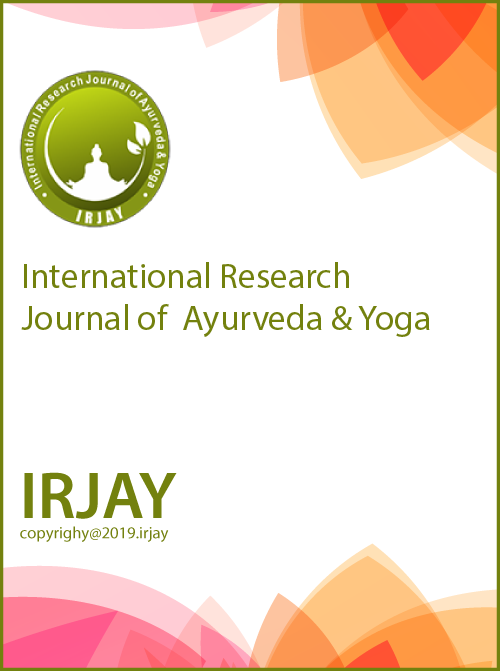Ayurvedic Management of Dadru Kushtha W.S.R. Tinea Cruris – A Case Study
Keywords:
Dadru, Tinea cruris, Laghu Manjishthadi Kwath, Shirish Twak lepaAbstract
Tinea infection, commonly referred to as ringworm, is a prevalent dermatological condition induced by fungi. “Jock itch,” also known as tinea cruris, predominantly impacts the groin, perineal, and perianal regions. Merely 20%–30% of people have skin issues. In Ayurveda, all categorized skin illnesses are classified as Kushtha Roga. In Ayurveda, skin disorders are primarily categorized as Mahakushtha and Kshudrakushtha, with Kushtha vyadhi regarded as Mahagada due to its chronic nature and tendency to repeat. Darshana and Prashna Pariksha are able to diagnose the condition based on the common clinical signs, which include excessive and intense itching as well as red circular skin lesions. The condition is characterized by heightened levels of Pitta and Kapha Dosha, particularly Kapha. The condition can be managed from an Ayurvedic perspective, resulting in minimal or no recurrence of the disease. Shamana chikitsa and Bahiparimarjana chikitsa will be helpful in the treatment of Dadru. A 34-year-old female patient has been displaying symptoms of Dadru Kushtha, also known as tinea cruris, for the past 8 months. She has already had advanced medical treatment; however, there has been a rebound. The patient had treatment for 28 days with Laghu Manjishthadi Kwath as the internal medicine and Shirish Twak Lepa as a topical application on an outpatient basis. The patient was evaluated for enhancement in signs and symptoms following 28 days of treatment. The patient was satisfied with the treatment they received and reported that Kandu, Daha, Raga, and Mandala were all getting better.
Downloads
References
Shastri K, Chaturvedi G. The Carak Samhita of Agnivesha, Chikitsasthana, Kushthachikitsa, 7/13. Elaborated Vidyotini Hindi Commentary. Varanasi: Chaukhambha Bharti Academy; Revised edition 2022. p. 224.
Majalekar SA, More MM. Ayurveda management of Dadru Kushtha: Case series. World J Pharm Medical Res. 2021;7(2):201-4.
Shastri K, Chaturvedi G. The Carak Samhita of Agnivesha, Chikitsasthana, Kushthachikitsa, 7/13. Elaborated Vidyotini Hindi Commentary. Varanasi: Chaukhambha Bharti Academy; Revised edition 2022. p. 223.
Shastri A. Sushruta Samhita: Nidana Sthana, Kushthanidana 5/5, Ayurveda Tattva Sandipika. Vol. 1. Varanasi: Chaukhambha Sanskrit Sansthan; 2010. p. 320.
Tripathi B. Vagbhatta Ashtangahridayam: Nidanasthana, Kushtha Switra-Krimi Nidana 14/10, Nirmala Hindi Commentary. Delhi: Chaukhambha Sanskrit Pratishthan; 2014. p. 528.
Sharma RK, Das B. Charak Samhita, Indriyasthana, Yassyashyavanimittiyamindriyama, 9/8. Varanasi: Chaukhamba Sanskrit Series Office, Chowkhamba Press, Varanasi; Reprint edition 2012. p. 569.
Shastri K, Chaturvedi G. Agnivesha Charaka Samhita: Sutra Sthana, Santarpaniya Adhyaya 23/6, Vidyotini Hindi Commentary. Vol. 1. Varanasi: Chaukhambha Bharati Academy; 2005. p. 436.
Lakkawar M, More A, Rai S, Tiwari SS. Leads towards management of dermatophytosis (Dadru) with Ayurvedic intervention – an experience. J Ayurveda Case Rep. 2022;5:156-62.
Bhagwan D. Charaka Samhita. 3rd ed., Vol. 1. Varanasi: Chaukhambha Sanskrit Series; 1992. p. 92.
Shastri R, editor. Bhaishajya Ratnavali of Shri Govind Das, Kushtha Chikitsa 54/66-67. Edited and enlarged by Bhisagatna Shri Brahma Shankar Mishra. “Vidyotini” Hindi Commentary Analysis with Appendixes by Shri Kaviraj Ambikadatta Shastri. Varanasi: Chaukhamba Prakashan; Reprinted 2018. p. 891.


